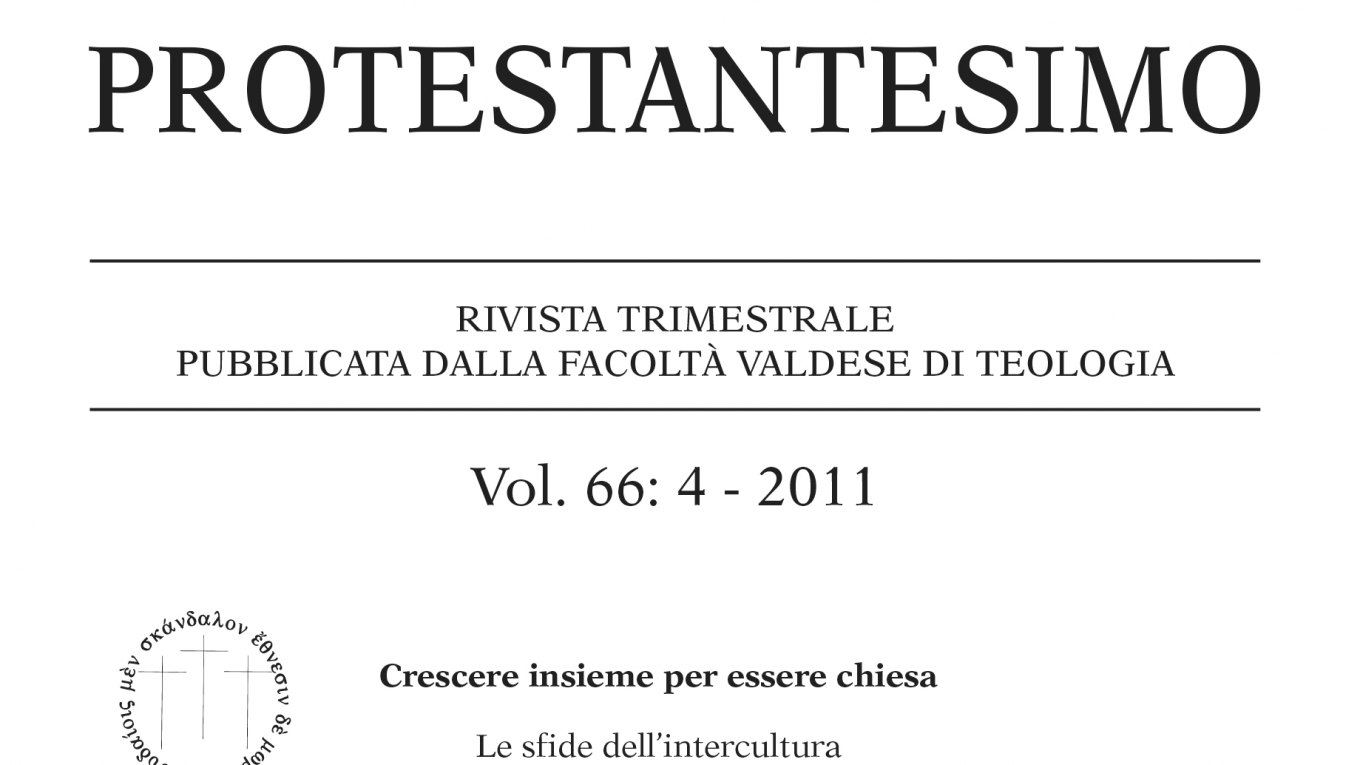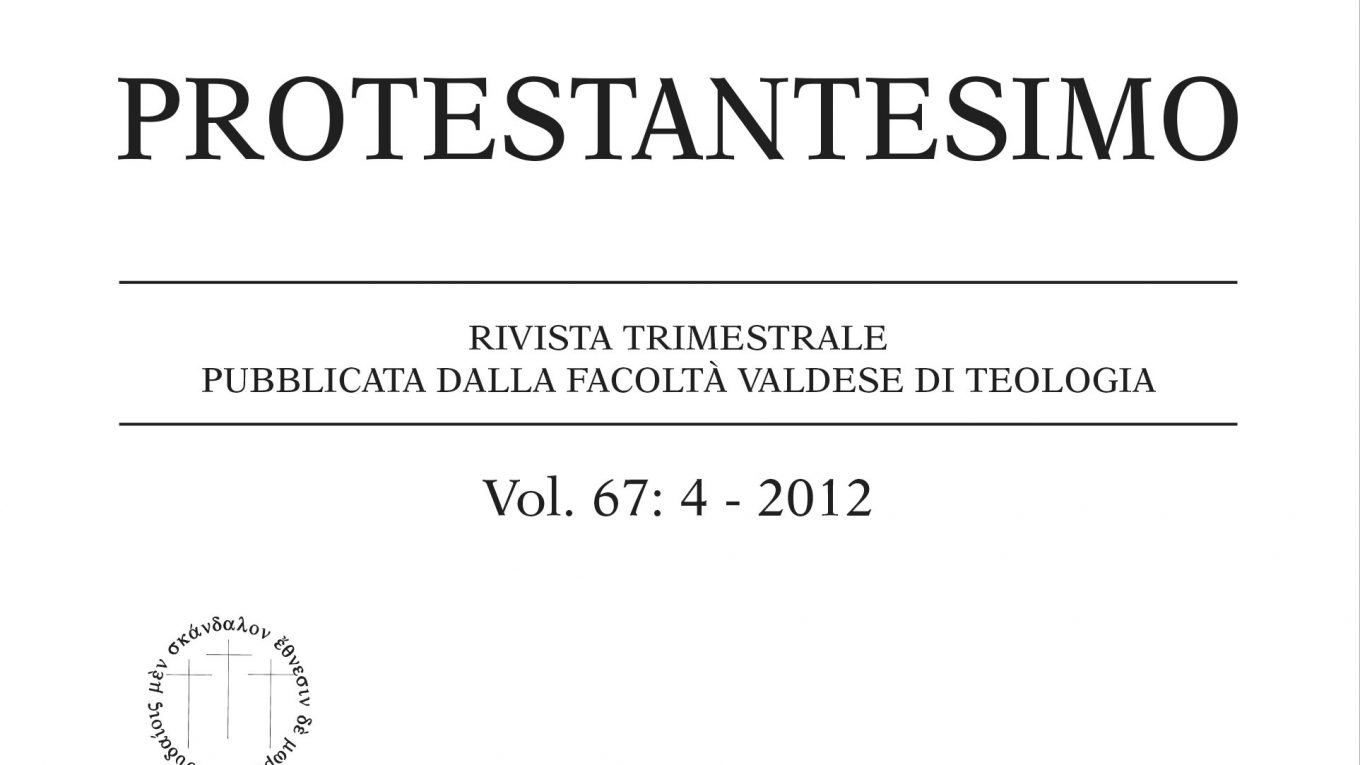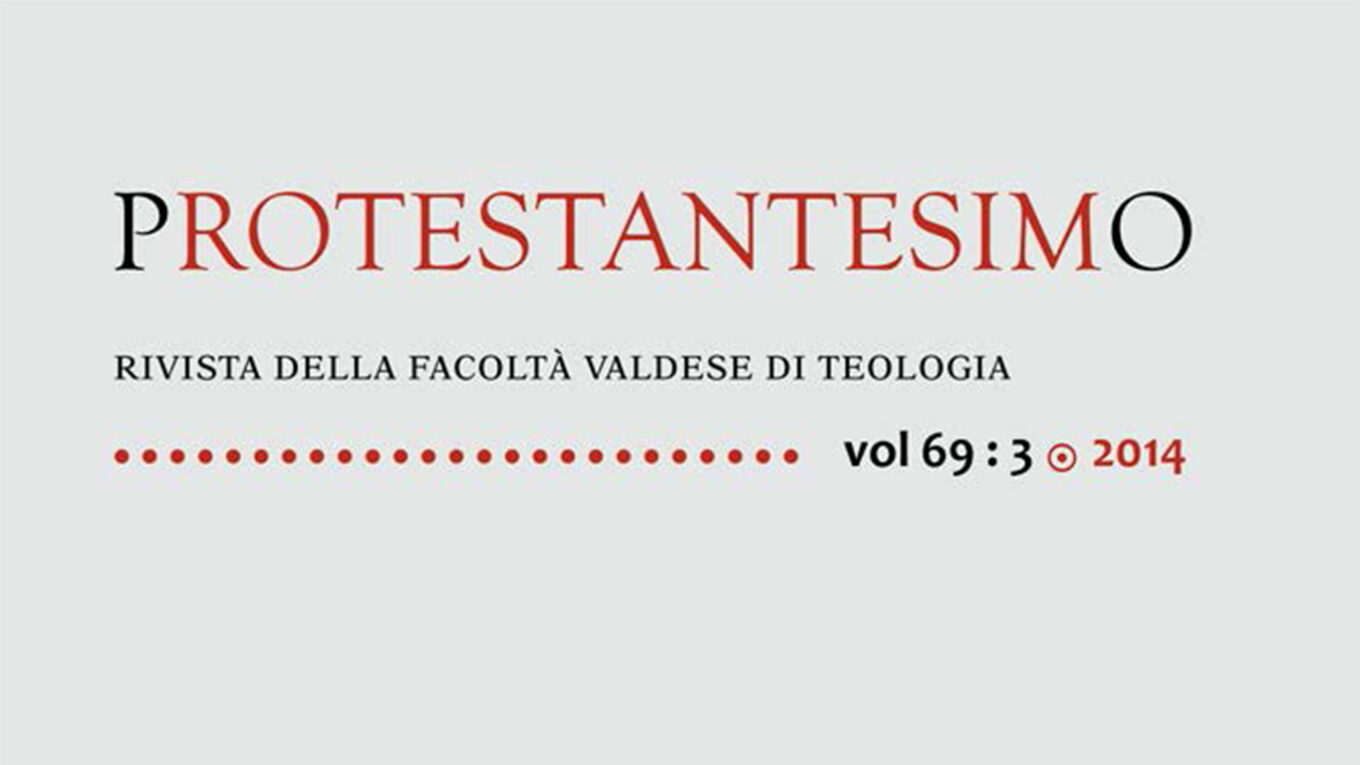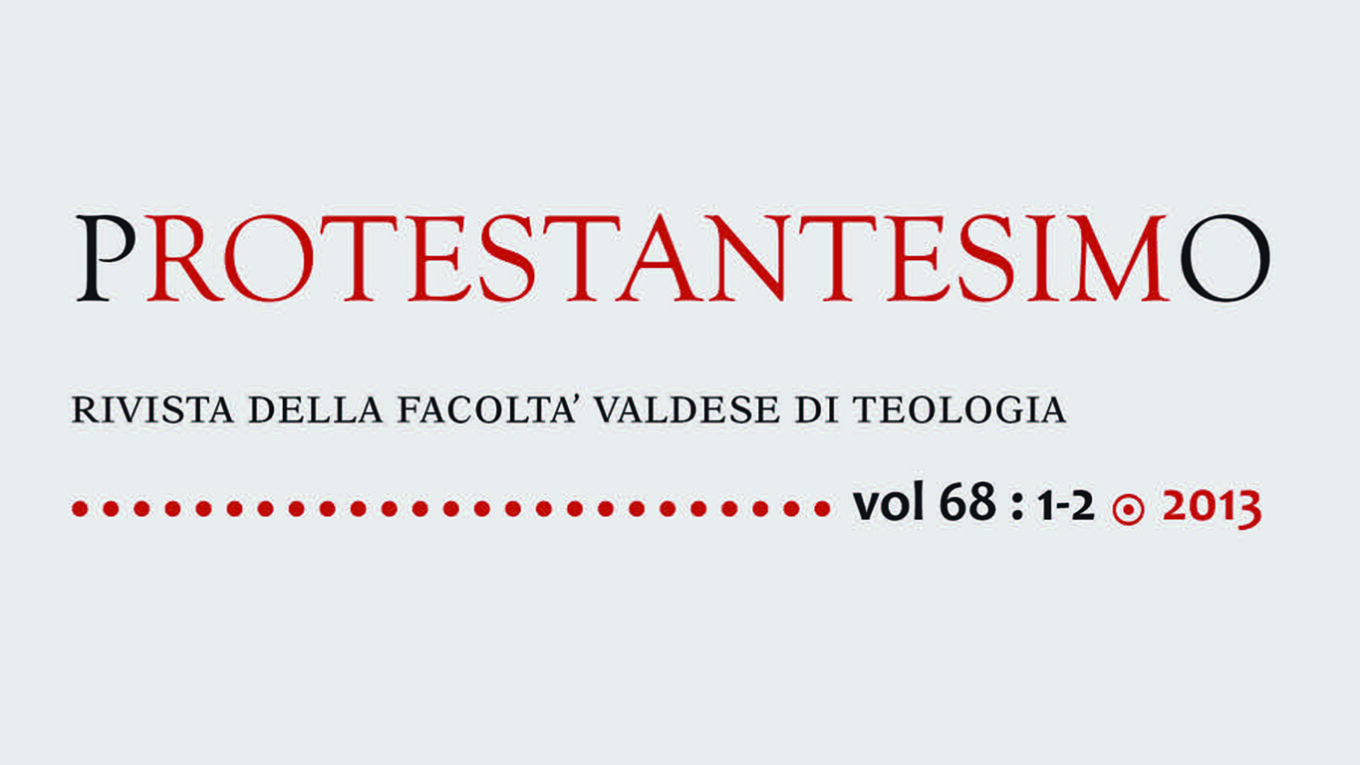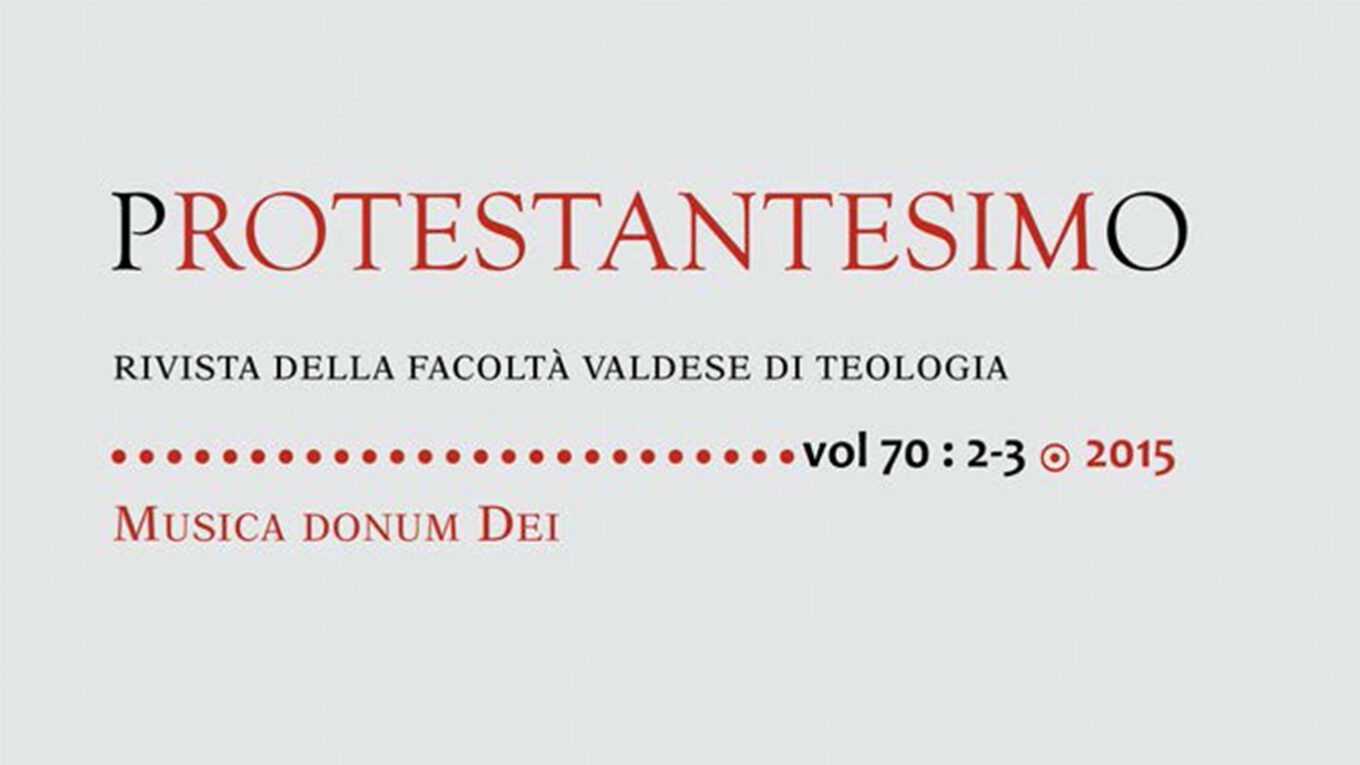Autore: wp_5978506
PROTESTANTESIMO VOL 66 : 3
PER ERMANNO GENRE
Sergio Rostagno, Primo comandamento; Elisabeth Parmentier, Il teologo pratico, artigiano di linguaggi; Jéròme Cottin, Dio è bello? La dimensione estetica della teologia; Henry Mottu, Salvare l’onore dell'”altra Germania”? Dietrich Bonhoeffer e la congiura del 20 luglio 1944 contro Hitler; Flavio Pajer, Da Toledo a Roma via Strasburgo: per una cultura religiosa pubblica secondo Costituzione; Yann Redalié, Il ministero ecclesiale. Un’ «opera bella» oggetto di legittimo desiderio (I Tim. 3,1); Enrico Benedetto, Appunti sulla «diaconia del gesto» nel Vangelo secondo Marco; Fulvio Ferrario, Dall’accoglienza alla benedizione. Una riflessione etica, tra dogmatica e teologia pratica
PROTESTANTESIMO VOL 66 : 4
Crescere insieme per essere chiesa
Le sfide dell’intercultura
A cura di Andreas Köhn, Yann Redalié
Pino Luca Trombetta, Le religioni dei migranti. Appunti per uno studio sociologico; Paolo Naso L’immigrazione evangelica in Italia; George G. Ennin, Michael Nausner, Una visione africana del mondo. Alcuni approfondimenti sociali, religiosi e culturali; Yann Redalié, Piste bibliche per una teologia interculturale; Elymas D. Newell, Istanze etiche africane e l’interpretazione del Nuovo Testamento. Le beatitudini del Sermone sul Monte (Mt. 5) e i proverbi africani; Corinne Lanoir, Quale didattica per una formazione teologica interculturale? Luana Redalié, Variabili culturali: comunicazione e conflitti in un contesto interculturale; Jonathan Terino, Insieme per essere chiesa: il cammino verso l’integrità della fede
PROTESTANTESIMO VOL 67 : 4
Lothar Vogel, Il pastorato evangelico fra vocazione e scienza – considerazioni a partire da Martin Lutero e Giovanni Calvino; Fulvio Ferrario, Teologia tra vocazione, professione e scienza. La ragione credente tra chiesa e società secolare; Massimo Di Gioacchino, Evangelizzare gli italiani, salvare l’America: l’Italian Mission della Methodist Episcopal Church degli USA (1908-1916); Cesare Milaneschi, La cattolicità della chiesa nel pensiero di Ugo Janni
PROTESTANTESIMO vol 69 : 3
Enrico Benedetto, Commemorare il futuro; Fulvio Ferrario, Vocazione e annuncio. A proposito del V centenario della Riforma; Sergio Rostagno, Riprendiamoci la Riforma!; Dietrich Korsch, Gli incontri ecumenici oggi; Claudio Tron, La predicazione dell’evangelo in schemi di polarità; Luca Ghiretti, Practical and experimental divinity e liberazione umana. Un tentativo di analisi critica gramsciana alla «religione di Wesley»
PROTESTANTESIMO vol 68 : 1-2
Enrico Benedetto, Una rivista unica ma non univoca; Gabriella Caramore, Ai «rabdomanti della luce». La profezia nel mondo contemporaneo; Paolo Ricca, Una teologa sul confine; Mare Boss, Tesi per una teologia ecclesiale e scientifica, missionaria e civile; Yvonne zu Dohna, Gli sguardi dello Spirito: tra Ignazio, Lutero, Caravaggio, Rembrandt; Daniele Garrone, «Perché proprio io?». Contestare la chiamata; Jean-Louis Ska, Chiamare ed essere chiamati; Yann Redalié, Essere presente al presente. Il «benessere» è un motivo biblico?; Roberto Bottazzi, Resilienza e resa. Psicologia, teologia e spiritualità in dialogo; Roberto Bottazzi, Fede e resilienza. Risonanze bibliche come ipotesi operativa; Letizia Tomassone, Il valore della Parola. Laura Krauss o della ricezione creatrice; Laura Greig Krauss, An experimental Introduction to the Hermeneutic of Reception-History; Ilenya Goss, Dalla filosofia del limite al testo biblico come traccia per il pensiero: libertà e male in Kant; Massimo Marottoli, Una lettura sinottica alle figure di Edipo, Achab e Giobbe; Gesine von Kloeden-Freudenberg, 1517-2017: la Riforma, un cammino. Il Catechismo di Heidelberg , da Ursinus a Nemo e James Band; Gunnar Wiegand, Provvidenza versus finalità: un Kant semi-inesplorato; Fulvio Ferrarlo, Il cielo vuoto di Umberto Galimberti
PROTESTANTESIMO vol 70 : 1
PROTESTANTESIMO vol 70 : 2-3
MUSICA DONUM DEI
Editoriale Inneggiare; EricNoffke, La musica in prosa nel Nuovo Testamento; Jolando Scarpa, Il pensiero musicale in Lutero. Ein feste Burg oltre l’icona della Riforma; Gianni Long, Un’inutile abiura; Emanuele Fiume, Il Salterio ugonotto: una Confessione in musica; Daniele Cristiano Iafrate, Da Lipsia a Neviso passando per Rio… L’accompagnamento strumentale del canto comunitario; Giorgio Tourn, Psaumes ercantiques: una teologia; Gabriella Ballesio, Il Canzoniere di Agape. La stagione rimossa; Sante Cannito, L’innologia protestante contemporanea; Ilenya Goss, Il canto in chiesa, preghiera in musica
abstract N 75 : 2
Lothar Vogel, Umanesimo biblico e influenze sassoni
Questo contributo abbozza l’operato riformatore di Zwingli a Zurigo negli anni tra il 1519 e il 1523, contestualizzandolo nel tessuto cittadino. Come suggerito dalle affermazioni autobiografiche del protagonista, si pone in risalto, per questo periodo, la continuità di un approccio cristocentrico ispiratosi a Erasmo da Rotterdam, invece di ipotizzare una svolta o perfino conversione di Zwingli dovuta all’influsso di Lutero. Al tempo stesso, un confronto delle prime traduzioni del Nuovo Testamento stampate a Zurigo nel 1524 con le edizioni curate dall’équipe attorno a Lutero dimostra l’influsso di Wittenberg sulle attività zurighesi.
Lothar Vogel, Biblical Humanism and Saxon Influences
This contribution sketches the work of Zurich’s Reformer Huldrych Zwingli between 1519 and 1523, contextualising it in its urban setting. As is suggested by Zwingli’s autobiographical affirmations, this period is highlighted as a continuum of Christocentric orientation inspired by Erasmus of Rotterdam, instead of hypothesizing a sort of conversion caused by the influence of Martin Luther. At the same time, a comparison between the first translations of the New Testament printed in Zurich in 1524 and the editions produced by Luther’s working group show the impact of Wittenberg on the Swiss Reformation.
Emidio Campi, Dalla Riforma «zwingliana» alla Riforma «svizzera». Quattro decenni di ricerca: una panoramica bibliografica e prospettive future
In questo contributo si dà una sintesi degli ultimi quarant’anni di ricerca su Zwingli e sulla Riforma in Svizzera. Anzitutto, sono presentate le principali edi- zioni di fonti curate in quel periodo, tra le quali spiccano gli scritti esegetici di Zwingli sul Nuovo Testamento, la Disputa di Baden, il Consensus Tigurinus e gli epistolari di Oswald Myconius e Heinrich Bullinger. Per quanto concerne, invece, l’interpretazione del pensiero teologico di Zwingli viene rilevata la crescen- te difficoltà di ricondurlo a un tema centrale. Inoltre, in sintonia con il paradig- ma storiografico della confessionalizzazione, si individua un crescente interes- se per i riformatori della seconda generazione Un’approfondita valutazione del processo complessivo della Riforma svizzera nel suo contesto politico e cultura- le è infine presentata come esigenza della ricerca futura.
Emidio Campi, From the «Zwinglian» to the «Swiss» Reformation. Four Decades of Research. The Current Status and Future Prospects
This article gives an overview of the last forty years of research on Zwingli and the Swiss Reformation. Firstly, the most important recent editions of sources are brought in, among which we find Zwingli’s exegetical writings on The New Tes- tament, the Disputation of Baden, the Consensus Tigurinus and the correspondence of Oswald Myconius and Heinrich Bullinger. Furthermore, this contribu- tion emphasizes the increasing difficulty in identifying a common denominator of Zwingli’s theological thought and, in keeping with the paradigm of “confessionalization”, a growing interest in the second generation of Reformers. Lastly, a deepened understanding of the entire process of the Swiss Reformation in its political and cultural context is a desideratum of future research.
Ermanno Genre, La Riforma a Zurigo: Zwingli e lo jus liturgicum
Le chiese riformate hanno ricordato, nel corso del 2019, i cinquecento anni della Riforma a Zurigo, iniziata con la predicazione di Zwingli. In questo contributo l’autore ripercorre alcuni momenti centrali della riforma liturgica zwingliana, dall’inaugurazione della lectio continua al tentativo di riformare il canone della messa (1523), e ancora con la (prima) liturgia della cena del Signore inaugurata durante il triduo pasquale del 1525, che pose fine alla celebrazione della messa. La rivisitazione liturgica prosegue con l’ultimo testo liturgico del riformatore (fidei expositio) dedicato al re di Francia e pubblicato poco prima della sua morte (1531). Una eredità liturgica, quella di Zwingli, problematica per gli stessi riformati, oggi partecipi di una ricerca liturgica ecumenica a tutto cam- po. Una eredità che non può prescindere, in ogni caso, da una «libertà liturgica evangelica» in permanente ricerca, come attestano i lavori di Christian Walti e Ralph Kunz, difensori di una «libera agenda liturgica».
Ermanno Genre, The Reformation in Zurich: Zwingli and the Jus Liturgicum
Reformed Churches have celebrated, during 2019, the 500th anniversary of the Reformation in Zurich, which started with Zwingli’s preaching. In this article, the Author goes over some central moments of Zwingli’s reformation of the liturgy, from the inauguration of the lectio continua to the attempt to reform the canon of Mass (1523), and then the (first) liturgy of the Lord’s Supper, inaugurated during the Easter triduum in 1525, which marked the end of the celebration of Mass. The changes in the liturgy continues with the last liturgical text of the Reformer (fidei expositio) dedicated to the king of France and published not long before his death (1531). Zwingli’s liturgical inheritance has been problematic even for the Reformed, who nowadays share a complete ecumenical liturgical research. An inheritance which cannot rule out the «Protestant liturgical freedom» permanently being researched, as shown by the studies of Christian Walti and Ralph Kunz, who favour a «free liturgical agenda».



